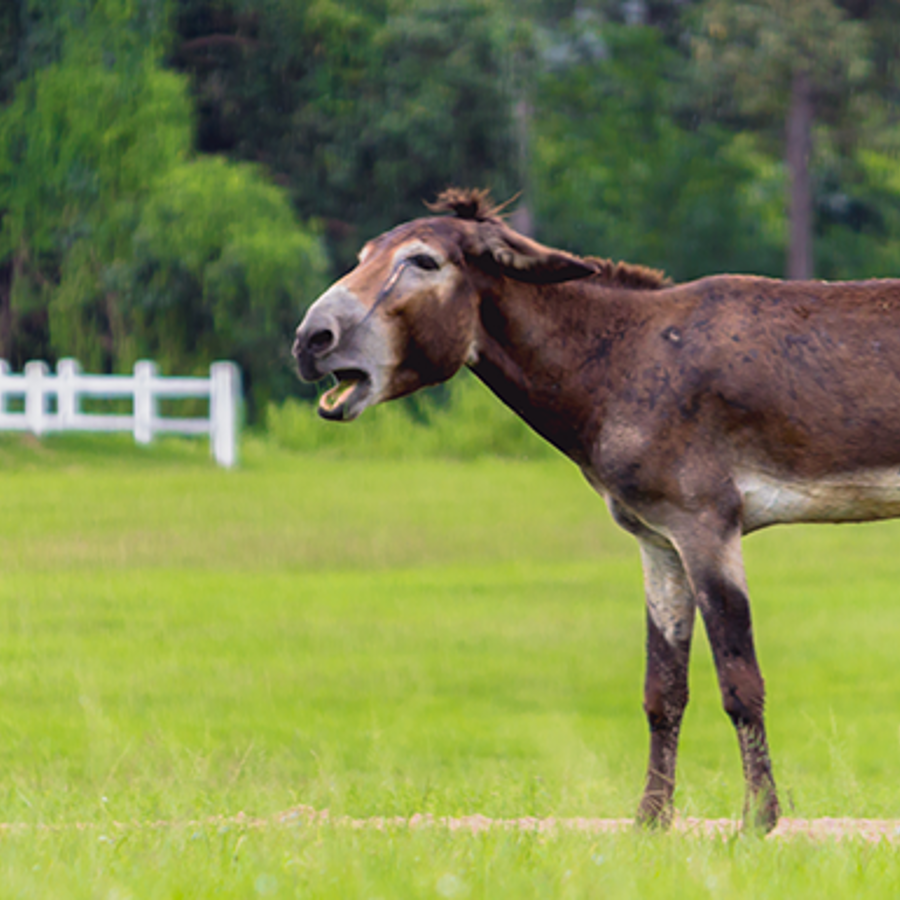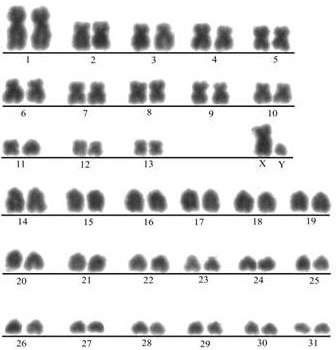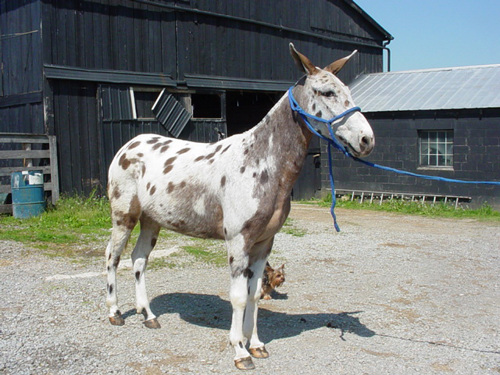
Why can’t mules breed?
June 20, 2007

- Related Topics:
- Speciation,
- Evolution,
- Chromosomes,
- Meiosis
A middle school student from Michigan asks:
“Why can’t mules breed? I understand that a horse and a donkey make a mule but why can’t 2 mules have a baby mule?”
Editor's Note (10/21/23): The article below describes how mules are sterile due to an inability to produce sperm or eggs. While this is broadly true,1-2 in biology there are exceptions to almost every rule. There have been several documented examples of female mules successfully conceiving and giving birth.3-5
You're right, a horse and a donkey can have babies together. A male horse and a female donkey have a hinny. A female horse and a male donkey have a mule.
But hinnies and mules can't have babies of their own. They are sterile because they can't make sperm or eggs.
Counting chromosomes
They have trouble making sperm or eggs because their chromosomes don't match up well. And, to a lesser extent, because of their chromosome number.
A horse has 64 chromosomes and a donkey has 62.
A mule inherits 32 horse chromosomes from mom and 31 donkey chromosomes from dad, for a total of 63 chromosomes.
To understand why this is a problem, we need to understand how sperm and eggs are made. And to understand that, we need to go into a bit more detail about chromosomes.

Remember, we have two copies of each of our chromosomes -- one from each parent. This means we have two copies of Chromosome #1, two copies of Chromosome #2, etc. However, this isn't entirely true for the mules.
The mule has a set of horse chromosomes from its mom. And a set of donkey ones from its dad.
These chromosomes aren't really matched sets. Normally, a Chromosome #1 is very similar to another Chromosome #1. It looks pretty much the same and has nearly the same set of A's, G's, T's and C's. For example, two human Chromosome 1's differ only every 1000 letters or so.
But a donkey chromosome doesn't necessarily look like a horse one. The donkey version of Chromosome #1 will look pretty different compared to the horse version of Chromosome #1. To top it off, the poor mule even has an unmatched, extra horse chromosome just sitting there.
Meiosis mismatch
To make a sperm or an egg, cells need to do something called meiosis. The idea behind meiosis is to get one copy of each chromosome into the sperm or egg.
For example, let's focus on Chromosome #1. Like I said, we have one from mom and one from dad. At the end of meiosis, the sperm or egg has either mom's or dad's Chromosome #1. Not both.
This process requires the chromosomes to match up in pairs during meiosis. To do this, they need to look pretty similar, meaning they are about the same size and have the same information.
Let's take a closer look at meiosis to see why this is.
The first step in meiosis is that all of the chromosomes make copies of themselves. No problem here...a mule cell can pull this off just fine.
It is the next step that causes the real problem. In the next step, all the same chromosomes need to match up in a very particular way. So, the Chromosome #1's need to line up together. But this can't happen in a mule very well.
Like I said, a donkey and a horse chromosome aren't necessarily similar enough to match up. The cell will struggle to get these lined up correctly.
And don’t forget about the unmatched chromosome! It can’t match up at all.
Add those together, and you have a real problem. The chromosomes can't find their partners and this causes the sperm and eggs not to get made.

So this is a big reason for a mule being sterile. But how is it alive at all?
Well, there are a couple of reasons. First, having an odd number of chromosomes doesn't matter for everyday life. A mule's cells can divide and make new cells just fine. Which is important considering a mule went from 1 cell to trillions of them!
Chromosomes sort differently in regular cells than they do in sperm and eggs. Regular cells (called somatic cells) use a process called mitosis.
The first step of mitosis is like the first step of meiosis. The chromosomes all make copies of themselves. But then instead of matching up, they just sort into two new cells. So for the mule, each cell ends up with 63 chromosomes. No matching needs to happen. And our lone horse chromosome is fine.
The other reason a mule is alive is that nothing on the extra or missing chromosome causes it any harm. This is a bit unusual, since in other species (like humans), extra DNA can result in miscarriages or genetic disorders.
There are exceptions to this, where a person can be born with an extra chromosome. Most of the time (but not always) a person with an extra chromosome is sterile. Those mismatched chromosomes make it hard to make viable sperm and eggs.
So mules are sterile because horse and donkey chromosomes are just too different. But they are alive because horse and donkey chromosomes are similar enough to mate.
Read More:
- Mules and hinnies aren’t the only horse hybrids! A Zorse Is a Horse-Zebra Hybrid
- Scitable: Hybrid Incompatibility and Speciation
- NPR: Befuddling Birth: The Case of the Mule's Foal
- Mules As Moms? Surprisingly Excellent Options for Equine Embryo Transfer

Author: Monica Rodriguez
When this answer was published in 2007, Monica was a Ph.D. candidate in the Department of Genetics, studying drosophila sex determination in Bruce Baker’s laboratory. Monica wrote this answer while participating in the Stanford at The Tech program.
 Skip Navigation
Skip Navigation
